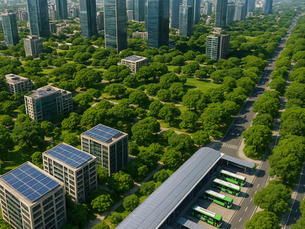From Bin to Business: How Gurugram Can Turn Waste into Impact
- Roma Panjabi

- Jul 27
- 4 min read
Updated: Jul 30
The Real Cost of Gurugram’s Waste
Every morning in Gurugram, waste collectors rush through narrow lanes, collecting overflowing bins from homes, markets, and offices. But behind this daily routine lies a deeper truth: Gurugram's waste is not just piling up—it's costing the city its health, environment, and business reputation.
With over 1,200 tonnes of solid waste produced each day and only a fraction of it treated scientifically, the city faces mounting landfills, public health issues, and environmental degradation. This waste crisis is no longer just a civic challenge—it's a missed economic opportunity.
The good news? If managed wisely, waste in Gurugram can become a valuable resource. Circular economy models, decentralised processing units, and business-led interventions offer a path forward. And companies in Gurugram have a major role to play.
The Waste Footprint of Gurugram
According to the Municipal Corporation of Gurugram (MCG):
1,200+ tonnes of solid waste is generated daily across sectors, RWAs, and commercial hubs.
Nearly 70% of this waste remains unsegregated, mixing plastic, food, medical, and hazardous waste.
Bandhwari landfill, Gurugram’s primary dumping ground, is already over 35 metres high, occupying 30+ acres.
Leachate from the site is polluting underground water in nearby villages including Gwal Pahari and Bandhwari.
Even newer colonies and luxury societies produce waste at an average of 450-500g per person daily, often without in-house segregation or composting.
This unmanaged waste leads to:
Burning of plastic waste and air pollution
Blocked drains and waterlogging during monsoons
Disease outbreaks due to garbage overflow
Loss of recyclable material value
Why Businesses in Gurugram Must Pay Attention
Most corporates and retail centres in Gurugram rely on outsourced waste pickup services. But the problems start where their premises end. Overflowing waste in adjacent public spaces, lack of segregation, and unsafe disposal can backfire on businesses in several ways.
1. Brand Reputation Risk
Offices and malls near dumpsites face negative public perception.
Customers are now aware and expect clean, sustainable business environments.
Investor ESG benchmarks now include waste practices of supply chains and regional impact.
2. Operational Disruptions
Blocked access roads due to garbage overflow affects logistics and footfall.
Fire risks from landfill methane buildup can shut down commercial activity.
Heavy fines from NGT or municipal authorities for non-compliance.
3. Employee & Customer Experience
Poor sanitation impacts employee health and productivity.
Negative customer sentiment for retail and hospitality brands.
High AQI and foul odour zones are pushing talent and business away.
The Missed Opportunity: Waste as a Business Resource
If waste is segregated and managed scientifically, it holds immense value:
Dry waste (plastic, metal, paper) can be recycled into furniture, roads, tiles, packaging material.
Wet waste (food, garden) can be converted into compost or bio-gas.
E-waste and medical waste, if isolated, can be safely handled and mined for critical materials.
Estimates suggest that Gurugram could save ₹100+ crore annually by reducing waste sent to landfills, recovering value, and avoiding fines.
Examples:
One composting unit at a mid-sized RWA processes 50 kg/day of wet waste into organic compost, saving over ₹1 lakh/year in disposal fees.
A DLF-backed project recycles plastic wrappers into pavement tiles at scale.
Local entrepreneurs are building businesses that upcycle textile and construction waste into new materials.
What Is Blocking the Circular Economy in Gurugram?
Despite models and success stories, adoption is slow. Why?
A. Lack of Waste Segregation at Source
Only 18–20% of households and offices practice 3-bin segregation.
Collection agencies often mix waste after pickup.
RWAs complain of limited guidance or infrastructure.
B. No Local Processing Units
Most areas transport all waste to Bandhwari.
There is no decentralised composting or MRF (Material Recovery Facility) network.
Builders and commercial properties do not install in-situ processing units.
C. Weak Policy Enforcement
Solid Waste Management Rules 2016 are poorly enforced.
Commercial generators above 100 kg/day are mandated to process waste on-site—few comply.
Lack of public reporting tools or grievance mechanisms.
D. Lack of Corporate Involvement
Waste is still seen as a government-only issue.
Companies focus on CSR for education or health but ignore waste.
Vendors are not required to disclose waste management practices.
CSR and ESG: Time for Corporate Gurugram to Step Up
Waste is no longer a back-of-the-building issue. It affects brand value, stakeholder trust, and business sustainability. Companies can make a huge impact by aligning their CSR and ESG goals to solve Gurugram’s waste crisis.
1. Adopt Local Waste Infrastructure Projects
Fund community composters and plastic recovery units.
Partner with NGOs to set up e-waste or dry waste collection points.
Sponsor waste audit and reporting tools for RWAs.
2. Close the Loop Within Company Premises
Ensure source segregation with 3-bin systems.
Install in-house composters or tie up with waste-to-energy vendors.
Use recycled office supplies, paper, and furniture.
3. Vendor and Supply Chain Compliance
Mandate vendors to disclose and follow waste protocols.
Include zero-landfill or recycling KPIs in contracts.
Promote packaging-free or reusable logistics systems.
4. Employee & Community Engagement
Conduct workshops for staff and families on waste literacy.
Encourage zero-waste cafeteria or refillable pantry models.
Support local artisans using upcycled materials.
5. Public Reporting & Recognition
Publish annual waste reports for facilities.
Nominate for Swachh Survekshan and similar recognitions.
Reward green champions and RWAs with the best waste track record.
The Way Forward: A City-Level Circular Vision
Solving waste cannot be the job of the municipality alone. It needs a multi-stakeholder vision.
A. Public-Private Partnerships (PPPs)
Companies can co-fund MRFs and biogas plants.
Builders can jointly set up construction waste recycling hubs.
Hotels and malls can pool resources to install large composting facilities.
B. Data and Transparency
Use tech to track waste movement, segregation, and recycling.
Dashboards for live waste tracking by wards and sectors.
Citizens should be able to report mixed waste pickups or dumping.
C. Behavioural Change Campaigns
Schools, colleges, and market associations should run regular campaigns.
Use street plays, competitions, and digital nudges to shift habits.
Reward communities that achieve zero-waste milestones.
Gurugram’s Waste Can Be Its Wealth
In a city driven by innovation and enterprise, there is no reason Gurugram should struggle with garbage. The waste economy is real, and the potential is immense. But it needs corporate commitment, community participation, and political will.
Let us not wait for Bandhwari to overflow again. Let us not export our garbage to the Aravallis or burn it in the open.
Let us treat waste as what it truly is: a resource. And let us build a Gurugram that doesn’t bury its future under its own trash.









Comments